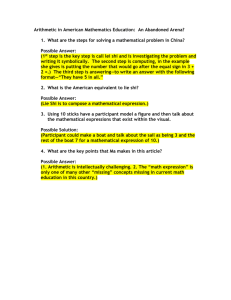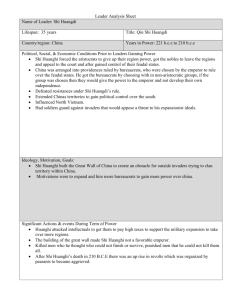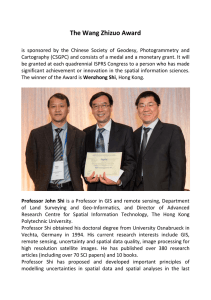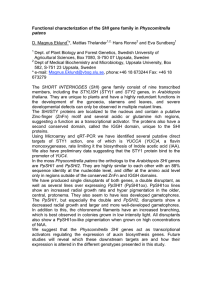Document 13517446
advertisement
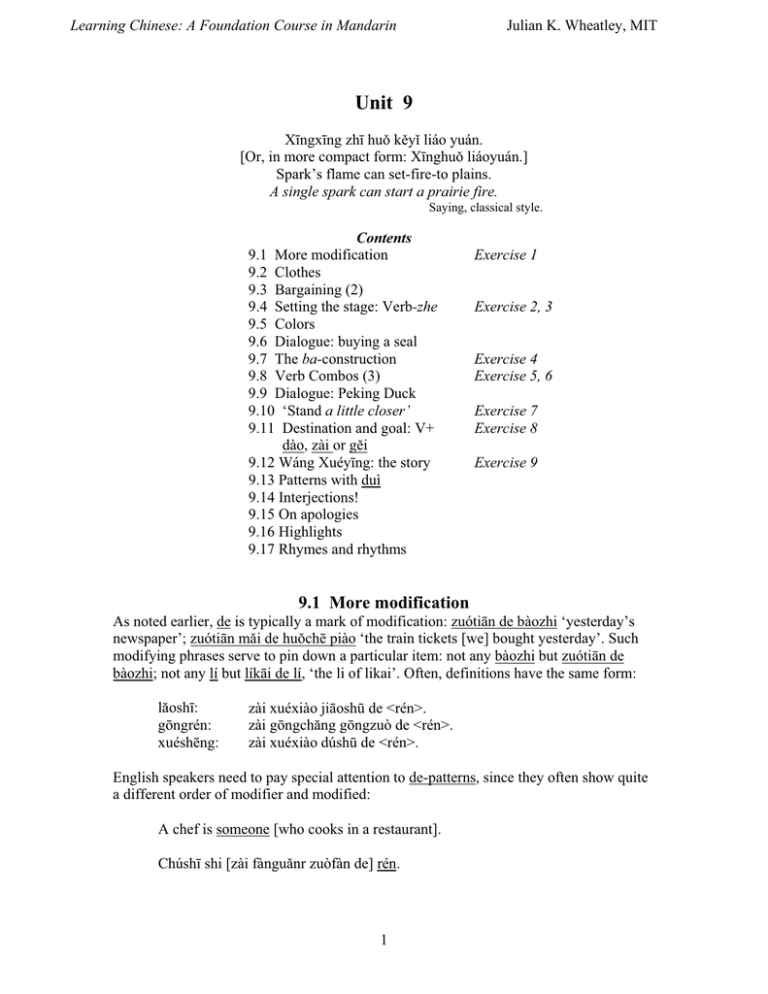
Learning Chinese: A Foundation Course in Mandarin Julian K. Wheatley, MIT Unit 9 XƯngxƯng zhƯ huԁ kČyӿ liáo yuán. [Or, in more compact form: XƯnghuԁ liáoyuán.] Spark’s flame can set-fire-to plains. A single spark can start a prairie fire. Saying, classical style. Contents 9.1 More modification 9.2 Clothes 9.3 Bargaining (2) 9.4 Setting the stage: Verb-zhe 9.5 Colors 9.6 Dialogue: buying a seal 9.7 The ba-construction 9.8 Verb Combos (3) 9.9 Dialogue: Peking Duck 9.10 ‘Stand a little closer’ 9.11 Destination and goal: V+ dào, zài or gČi 9.12 Wáng XuéyƯng: the story 9.13 Patterns with duì 9.14 Interjections! 9.15 On apologies 9.16 Highlights 9.17 Rhymes and rhythms Exercise 1 Exercise 2, 3 Exercise 4 Exercise 5, 6 Exercise 7 Exercise 8 Exercise 9 9.1 More modification As noted earlier, de is typically a mark of modification: zuótiƗn de bàozhi ‘yesterday’s newspaper’; zuótiƗn mӽi de huԁchƝ piào ‘the train tickets [we] bought yesterday’. Such modifying phrases serve to pin down a particular item: not any bàozhi but zuótiƗn de bàozhi; not any lí but líkƗi de lí, ‘the li of likai’. Often, definitions have the same form: lăoshƯ: gǀngrén: xuéshƝng: zài xuéxiào jiƗoshnj de <rén>. zài gǀngchăng gǀngzuò de <rén>. zài xuéxiào dúshnj de <rén>. English speakers need to pay special attention to de-patterns, since they often show quite a different order of modifier and modified: A chef is someone [who cooks in a restaurant]. ChúshƯ shi [zài fànguӽnr zuòfàn de] rén. 1 Learning Chinese: A Foundation Course in Mandarin Julian K. Wheatley, MIT 9.1.1 Other vocabulary: The following vocabulary is needed for exercise 1, below: wӽng shàng net on on the internet jiƗo péngyou exchange friends meet friends gǀngjù work-tool tool gànbu shèyӿngshƯ shoot-picture-expert a cadre; photographer political-worker xƯnwén bàodӽo news report the news wòfáng sleep room bedroom pƗizhào zhàoxiàng nóngmín agric.-people farmers zhòngdì plant-ground cultivate the soil zhèngfǎ fúwù government to serve VO ‘take photos (strike-reflection)’; VO ‘to take photos (reflect-likeness)’ Wԁ zhào <yí> ge xiàng, hӽo bu hӽo? Wǂ pƗi <yí> ge zhào, hăo bu hăo? Let me take a photo, okay? Wǂmen dào TiƗn’Ɨnmén Guӽngchӽng zhàoxiàng qu le. We went to TiƗn’anmen Square to take some photographs. ZuótiƗn wǂmen zài Pԃdǀng zhào le jӿ zhƗng xiàng. Yesterday, we took some photos in Pudong [Shanghai]. Exercise 1. a) Provide items that fit the following definitions: 1. Zhǀngguó rén chƯfàn de shíhou yòng de gǀngjù. 2. Wèi biérén zhàoxiàng de rén. 3. GČi bìngrén kànbìng de rén. 4. Wèi Zhǀngguó rénmín gǀngzuò de rén. b) Provide Chinese definitions based on the characteristics provided: 5. nóngmín: cultivate land in the countryside 6. jìzhČ: write news reports 7. fúwùyuán: serve [for the sake of] guests 8. wӽngyԁu: friends made online 2 Learning Chinese: A Foundation Course in Mandarin Julian K. Wheatley, MIT 9.1.2 Dialogue: Who’s in the photo? Máo Dàwéi is with the mother of one of his friends (whom he calls bómǎ ‘wife of father’s elder brother; auntie’). She is a photographer (shèyӿngshƯ). They are looking at photographs taken in the 30s when Máo Zédǀng was in Yán’Ɨn (in northern ShӽnxƯ). Bómǎ NƱ kàn, zhè shi Máo Zédǀng zài Yán’Ɨn. Máo TƗ pángbiƗnr de nèi ge rén shi shéi? Look, here’s Mao Zedong at Yan’an. Who’s that next to him? Bómǎ YòubiƗnr de shi Zhnj Dé; zuԁbiƗnr de shi Zhǀu Ɯnlái. NƱ kàn, hòubiƗnr de nèi liăng ge wàiguó rén shi SƯnuò hé SƯnuò fnjrén. . Máo SƯnuò fnjfù shi MƟiguó jìzhƟ, shì bu shì? The one on the right is Zhu De, the one on the left is Zhou Enlai. Look, those two foreigners in the back are [Edgar] Snow and Mrs. Snow. Bómǎ Duì, SƯnuò shi ge ‘guójì yԁurén’, xiàng Bái Qiú’Ɲn dàifu. Right, [Edgar] Snow was an ‘international friend’, like Dr. Norman Bethune. Máo And Zhu De? Zhnj Dé ne? The Snows were American reporters, right? Bómǎ Zhnj Dé shi jiƗngjun, cƗnjiƗ le Cháng ZhƝng. Zhu De was a general, who took part in in the Long March. Máo Cháng Chéng ne? The Great Wall? Bómǎ Bú shi Cháng Chéng, shi Cháng ZhƝng; Hóngjnjn cóng JӿnggƗng ShƗn zԁudào Yán’Ɨn. Not the Great Wall, the Long March, [when] the Red Army marched from Jingangshan to Yan’an. Máo O, Cháng ZhƝng, w΅ tƯngcuò le. Oh, the Long March – I heard it wrong. N shuǀ de shi 1935 nián de Cháng You’re talking about the Long March of ZhƝng ba. W΅ ywéi n shuǀ de 1935. I thought you said the Great Wall. shi Cháng Chéng! Bómǎ Jiùshi le! Zhnj Dé cƗnjiƗ le Cháng ZhƝng. Exactly! Zhu De took part in the Long March. Notes a) Yán’Ɨn: a city in a remote part of northern ShӽnxƯ; from 1937-47, it was the capital of the communist controlled part of China. b) Zhnj Dé, 1886 – 1976; close associate of Mao, and at the inauguration of the PRC, he was the Commander-in-Chief of the People’s Liberation Army (PLA). 3 Learning Chinese: A Foundation Course in Mandarin Julian K. Wheatley, MIT c) Zhǀu Ɯnlái, 1899 – 1976, Premier under the PRC. d) SƯnuò: Edgar Snow (1905 – 72), an American reporter, author of Red Star over China, based on interviews with Mao and others conducted at Yan’an after the Long March. His first wife, Helen Foster Snow, also a journalist, accompanied him for part of his stay in Yan’an. e) fnjfù ‘husband and wife’. Level toned fnj ‘man’ appears as the first syllable of fnjren ‘Mrs.’ (ie ‘man’s person’); falling toned fù ‘woman’ appears in words such as fùkƝ ‘gynecology (woman-section)’. f) Guójì yԁurén: a designation for foreigners who helped Chinese during hard times, especially in the 50s and 60s, when China was most isolated from the rest of the world. g) Bái Qinj’Ɲn: Norman Bethune (1890 – 1939), a Canadian physician who died of blood poisoning while serving as a doctor in the communist area. Mao wrote an essay on him that was once required reading in China. h) dàifu: ‘doctor; physician’; cf. yƯsheng. i) jiƗngjun ‘military officer; general’ j) cƗnjiƗ: ‘to join; participate in; take part in’. k) Cháng ZhƝng ‘The Great March’. In 1934, the Communist forces retreated from their base areas in rural JiƗngxƯ (known as the Jiangxi Soviet) under military pressure from the Kuomintang (Nationalist Party). They marched westwards at first, and then in a great arc northwards, ending up in Yan’an in 1935, a journey of almost 10,000 kilometers. l) JӿnggƗng ShƗn: The Jinggang Mountains in Jiangxi. m) Hóngjnjn: ‘the Red army’ n) yӿwéi: ‘think; believe [s/t that turns out to be incorrect] (take to be)’. 4 Learning Chinese: A Foundation Course in Mandarin Julian K. Wheatley, MIT 9.2 Clothes 25 years ago, the predominant color of clothing in the PRC was white for shirts, and dark blue or dark grey for most everything else, though on occasion, youth wore red scarves to show their political loyalty. Men, in those days, wore Mao suits, a type of attire originally promoted by Sun Yat-sen earlier in the 20th century to provide a formal dress for civil servants that looked modern but not completely western. So-called Mao suits are still called ZhǀngshƗnzhuƗng ‘Zhongshan tunics’ or ZhǀngshƗnfú ‘Zhongshan clothes’ in Chinese. In Mandarin, Sun Yat-sen is usually known not by the Mandarin rendition of Sun Yat-sen, Snjn YìxiƗn, but by his alternate name Snjn ZhǀngshƗn; Zhongshan, on the coast of Canton province, was his birthplace. Beginning in the late 1980s, clothing styles started to change in the PRC, and nowadays, there is little in the way of dress to distinguish people on the street in, say, Chengdu, from their counterparts in Chicago or Hamburg. However, Chinese styled garments (actually modern versions of more traditional garments), such as the following, are still seen: traditional mián’ӽo cháng páo<r> mӽguà<r> qípáo<r> cotton padded jacket long scholar’s robe men’s short coat ‘cheongsam’; woman’s long gown (with slit skirt) Zhǀngguó chuántԁng de yƯfu yԁu mián’ӽo, chángpáo, mӽguà, qípáo dČngdČng. Chinese traditional clothing includes padded jackets, robes, short coats, cheongsams, etc. Ordinary types of clothing are listed below. Most types of clothing are counted by way of the M-word jiàn; shoes and boots, however, are counted with shuƗng ‘pair’, or if singly, with zhƯ. clothing máoyƯ sweater (wool-clothing) jiákè jacket [based on the English] kùzi trousers nèiyƯ underwear (inner-clothes) niúzӽikù jeans (cow-boy-trousers) xié ~ xiézi shoes chènshƗn qúnzi duӽn kùzi chènkù wàzi xuƝzi shirt (lining-shirt) skirt shorts underpants (lining-trs) socks; stockings boots T xù<shƗn> T-shirt [from English ‘T-shirt’, by way of Cantonese, where xù is pronounced xut] formal wear [yí tào] xƯfu wӽnlӿfú yèlӿfú a suit ([a set] western-clothes) formal evening dress (f) (‘evening-ceremony-clothes’) formal attire; tuxedo (m) (‘night-ceremony-clothes’) 5 Learning Chinese: A Foundation Course in Mandarin Julian K. Wheatley, MIT Chinese has two words corresponding to English ‘wear’: chuƗn, literally ‘to pass through’ is used for clothing and shoes; dài is used for accessories, such as hats, belts and glasses: dài màozi hat glasses (‘eye-mirror’) yӽnjìng tàiyángjìng dark glasses (‘sun-mirror’) There is a third word, jì ‘tie; fasten; do up’, which is used for things such as neckties and seatbelts that in English also get ‘worn’: jì lӿngdài Ɨnquándài tie (‘neck-belt’) seatbelt (‘safety-belt’) Note The dài of lӿngdài, ‘belt’, is homophonous with dài meaning ‘wear’, but the two words are unrelated (and written with different characters). 9.2.1 Describing people in terms of their clothes People can be characterized in terms of the clothes they are wearing: Nӿ kàn, chuƗn niúzӽikù de nèi ge rén – tӿng shímáo de! Look at that guy in jeans--such style! ChuƗn hóng máoyƯ de nèi ge rén shi nČi wèi? Who’s the person in the red sweater? ChuƗn duӽn kùzi de nèi wèi shi shéi? Who’s the person wearing shorts? Dài tàiyángjìng de shi Lӿ Péng. The one with the sunglasses is Li Peng. Jì huáng lӿngdài de shì Zhnj RóngjƯ. Zhu Rongji’s the one with the yellow tie. Ménggԃ rén chuántԁng de yƯfu; hòutou de yáng nӿ kàndejiàn ma? 6 Learning Chinese: A Foundation Course in Mandarin Julian K. Wheatley, MIT 9.3 Bargaining, the way the Chinese might do it. Recall the earlier material (especially in Unit 8) on shopping and bargaining. Here is a more sophisticated dialogue that is envisionied as taking place between locals, so the only likely role for a foreign student is as a bystander, listening in. Because it takes place between Chinese, it is colloquial, and incorporates a number of quite idiomatic expressions, which are explicated in the notes. It is worth trying to enact the Chinese roles, but to be effective, you will need to sustain a convincing level of fluency. BČijƯng: Y runs a shop that sells leather jackets; Ji is a female customer. Jiӽ: Lӽobӽn, zhèi jiàn pídàyƯ duǀshao qián? Proprietor, how much is this leather coat? Y: YìqiƗnw·. ¥1,500. Jiӽ: Jiu zhèi yàngr de pídàyƯ yìqiƗnwԃ?! Tài hƝi le ba! Biéde dìfang gƝn zhèi jiàn chàbuduǀ yíyàng de, cái wԃbӽi duǀ kuài! Nӿ gČi yí ge gǀngdao diӽnr de jià! A jacket like that is ¥1,500?! That’s a ‘rip off’. At other places, coats almost exactly the same as this one are only ¥500 plus! Give [me] a more reasonable price! Y: N kƗi shénme guójì wánxiào! Zhè shi zhƝn pí de! N mǀmo, sh΅ugn duǀ ho! N zài biéde dìfang kàndào de yídìng shi jihuò! Nèi yàng de yƯfu, n chuƗnbulio duǀ cháng shíjiàn jiu huài le. W΅ zhèi jiàn, bo nín chuƗn tƗ ge jshí nián méiyou wèntí! What sort of an ‘international joke’ are you pulling? This is a real leather one! Feel it, the texture’s so nice! Those you saw elsewhere must be fakes! That sort of clothing, you can’t wear it for any length of time before it’s worn out. The one I have, it’s a sure thing that you can wear it several decades without a problem! Jiӽ: Lӽobӽn, nӿ jiu chuƯ ba! Fӽnzhèng chuƯniú yČ bú shàngshuì! ‘Boss’, you’re having me on! Still, bragging’s not taxed! Y: Zhèiyàng ba, dàjiČ, w΅ kàn nín shi zhƝnxƯn yào mi. W΅ jiu fàng yìdinr xiČ. N gČi yìqiƗnsƗn zČnmeyàng? How about this, sister, I see that you’re serious about buying [it]; okay I’ll take a hit. How about you pay ¥1,300? Jiӽ: YìqiƗnsƗn bù xíng. Wԃbӽi, nӿ mài bu mài? ¥1,300’s not on. ¥500 – you selling or not? Y: Aiya, dàjiČ, nín z΅ngdČi ràng w΅ zhuàn yìdinr ba! W΅ shànghuò jiu bƗbi. N duǀ gČi yìdinr. Nèi dinr qián, duì nín lái shuǀ, jiùshi j dùn fàn qián, dànshi duì w΅ lái shuǀ, hČn zhòngyào. W΅ yào zhuàn yìdinr qián gČi w΅ háizi jiƗo xuéfèi. Gosh, sister, you have to let me earn s/t! It takes me ¥800 to buy the stock. Pay me a bit more. The extra is only a couple of meals for you, but for me, it’s crucial. I need to earn some money to pay for my kid’s tuition. 7 Learning Chinese: A Foundation Course in Mandarin Julian K. Wheatley, MIT Jiӽ: BƗbӽi zČnmeyàng? ¥800 then? Y: BƗbi tài sho le; zài duǀ gČi yìdinr. YìqiƗn’èr. ¥800’s too little; give a little more. ¥1,200. Jiӽ: Jiԃbӽi. ¥900. Y: YìqiƗnyƯ. Yàobu, zán q· ge zhǀng, zČnmeyàng? N gČi yìqiƗn: w΅ sho zhuàn yìdinr, nín duǀ gČi dinr. ¥1,100. Or else how about splitting the difference? Pay ¥1,000. I earn a bit less, you pay a bit more. Jiӽ: Bù xíng, jiԃ bӽi, nín mài bu mài? Nӿ bú mài wԁ jiu zԁu le. Nope; ¥900 – take it or leave it. If you don’t take it, I’m leaving. Y: Ho, ho, ji·bi jiu ji·bi. Ai, dàjiČ, nín kČ zhƝn néng tojià-huánjià. W΅ kČ zhƝn fú le nín le. Ho le, dàjiČ, jiu suàn zán jiƗo ge péngyou. Nín gČi w΅ jièshao j ge péngyou lai, duǀ mi dǀngxi, ho bu ho?… Zhè shi nín de pídàyƯ. Náho. Okay, okay, ¥900 then. Gosh, sister, you can really bargain! I’ve got to hand it to you! So, sister, that makes us friends. How about introducing some friends to me [and] buying more… Here’s your coat. Hold on to it! Jiӽ: Zhè shi jiԃbӽi zhČng. Nӿ shԃshԃ. Here’s ¥900 exactly – count it. Y: Méi cuò, zhèng ho ji·bi. Nín màn z΅u. HuƗnyíng nín zài lái. Correct, exactly ¥900 . Take care. Please come back again. Based on Chen Tong, 09/05 Notes: tài hƝi le ‘too black’, which suggests ‘extortion’; ‘rip off’ has the right level of informality, but may be too offensive. gǀngdao SV: used regionally to mean ‘friendly; affable’; so gǀngdao (hédào in the South) diӽnr de jià ‘a more reasonable price’. guójì wánxiào ‘international joke’, meaning ‘out of the realm of possibilities; outlandish; off the wall’ ‘real leather one’ zhƝn pí de mǀ ‘to feel’ shԁugӽn ‘the feel [of it] (hand-feel)’ jiӽhuò ‘fakes (false-goods)’ chuƗnbuliӽo V-bu-liӽo ‘cannot V’; cf. §9.8.3 (b) bӽo ‘keep; ensure; guarantee’; contrast bӽo ‘full’ chuƗn tƗ a case where tƗ refers to a thing, not a person. ge jӿshí nián with jӿshí nián measured by the M-word ge: ‘wear it for a couple of decades’ 8 Learning Chinese: A Foundation Course in Mandarin chuƯ Julian K. Wheatley, MIT ‘blow’, but here, short for chuƯniú or chuƯ niúpí; see next entry. chuƯniú ~ niúpí VO ‘talk big; have [one] on (blow-ox <skin>)’ fӽnzhèng ‘anyway (overturned-upright)’ ‘sincere (real-heart)’ zhƝnxƯn fàng xiČ ~ xuè ‘bleed (put-blood)’, here in the sense of ‘make the sacrifice’; ‘blood’ is more often xiČ in this context, s/t xuè. zԁngdČi ‘must; have to (always-must)’ ràng ‘let [one do s/t]’ shànghuò VO ‘replenish stock (load-goods)’ duì nín lái shuǀ ‘in your case; for you (to you come say)’ zhòngyào SV ‘important; crucial (heavy-need)’ jiƗo xuéfèi VO ‘deliver tuition (deliver study-expenses)’; gČi wԁ háizi jiƗo xuéfèi ‘for my child hand-over tuition’ zài duǀ gČi yìdiӽnr ‘give a bit more again’; cf. §8…. yàobu ‘if not’; a reduced form of yàoburán ‘otherwise (if-not-so)’; also bùrӽn ‘not so’. zán colloquial, or regional, for zánmen; cf. §2… qԃ ge zhǀng ‘split the difference (fetch the middle)’ nín kČ zhƝn néng … ‘you sure really can…’; kČ here, an adverb. tӽojià-huánjià VO-VO ‘bargain (ask a price-return a price)’ fú ‘to submit’ kČ zhƝn fú le nín le ‘got to hand it to you (sure really submit LE you LE)’ suàn V ‘calculate; reckon’ jiƗo ge péngyou jiao ‘hand over; meet’: jiƗo ge péngyou ‘make a friend’; jiƗo xuéfèi ‘hand over tuition’ jiԃbӽi zhČng = zhČng jiԃbӽi; zhČng ‘whole; entire; fully’. Cf. ZhČng sƗn diӽn or sƗn diӽn zhČng ‘3 o’clock on the dot’. To be contrasted with zhèng ‘exactly; precisely’ – see next entry. zhèng hӽo jiԃbӽi ‘exactly ¥900 (precisely-good 900)’ HuƗnyíng nín zài lái. In China, this phrase is often translated literally into English as ‘Welcome to come again!’. 9 MIT OpenCourseWare http://ocw.mit.edu 21G.103 Chinese III (Regular) Fall 2005 For information about citing these materials or our Terms of Use, visit: http://ocw.mit.edu/terms.


